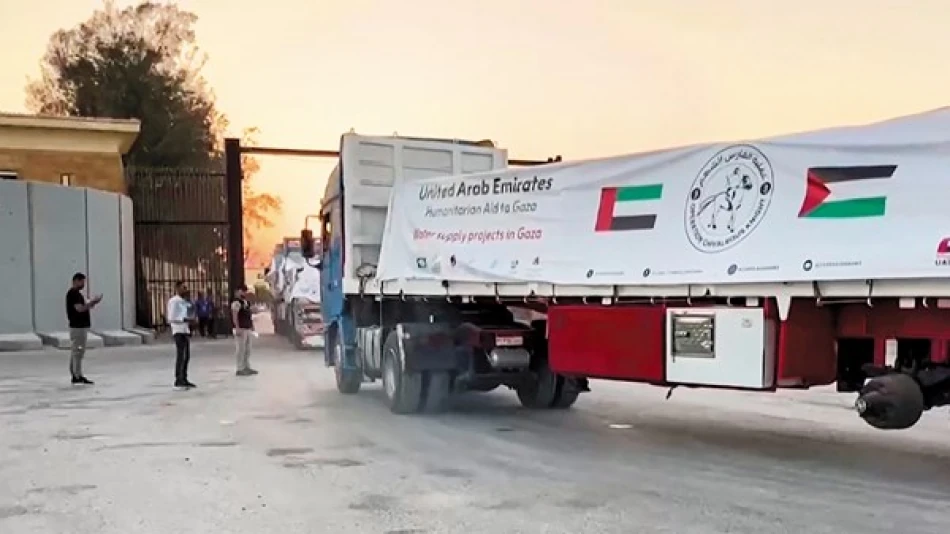
UAE Humanitarian Aid to Gaza Reflects Solidarity and Moral Commitment
UAE's $680 Million Gaza Relief Operation Emerges as Lifeline Amid Humanitarian Collapse
The United Arab Emirates has emerged as one of the most significant humanitarian actors in Gaza, spending approximately 2.5 billion dirhams ($680 million) over less than two years through its comprehensive "Operation Gallant Knight 3." As Gaza's infrastructure crumbles and over two million Palestinians face severe shortages, the UAE's systematic approach to relief—encompassing field hospitals, water desalination projects, and mass airdrops—offers a template for effective crisis response that contrasts sharply with traditional aid delivery methods.
Beyond Emergency Aid: Building Critical Infrastructure
Under direct orders from President Sheikh Mohammed bin Zayed Al Nahyan, the UAE's relief efforts extend far beyond typical humanitarian assistance. The operation has established field hospitals, treated hundreds of injured Palestinians in UAE medical facilities, and launched what officials describe as the largest desalinated water supply project from Egypt to southern Gaza.
The scale of infrastructure development sets the UAE apart from other international donors. While most countries focus on food and medical supplies, the Emirates has invested in water well maintenance, temporary housing for displaced families, and comprehensive medical care systems. This approach reflects lessons learned from previous humanitarian crises in Yemen and Syria, where short-term aid failed to address systemic infrastructure collapse.
Strategic Water Security Initiative
The UAE's water desalination project represents a particularly significant intervention. Gaza's water infrastructure has been severely damaged, leaving residents dependent on contaminated sources. By establishing a pipeline from Egypt and providing water treatment equipment, the UAE addresses a crisis that could persist long after immediate hostilities end.
Engineer Aed Abu Ramadan, head of Gaza's Chamber of Commerce and Industry, emphasized the critical need for water filtration systems and sterilization materials. "There's an urgent priority for solar cells and batteries to generate power for homes, tents, hospitals, and public institutions," he noted, highlighting how the UAE's comprehensive approach addresses interconnected infrastructure needs.
Diplomatic Leverage Through Humanitarian Leadership
The UAE's massive financial commitment serves multiple strategic purposes beyond immediate humanitarian relief. By positioning itself as Gaza's primary benefactor, the Emirates enhances its regional diplomatic influence and demonstrates its capacity for crisis management—qualities that resonate with both Arab populations and international partners.
This approach mirrors successful humanitarian diplomacy by countries like Turkey during the Syrian crisis and Qatar's role in Afghanistan. However, the UAE's emphasis on infrastructure development rather than purely consumable aid suggests a longer-term strategic vision for post-conflict reconstruction.
Coordinated International Response
Shadi Othman, spokesperson for the European Mission in Palestine, confirmed that UAE airdrops represent "one of the most important steps to mitigate the devastating humanitarian crisis." He revealed ongoing European-Israeli agreements to increase aid flows, suggesting the UAE's unilateral action may have pressured other actors to enhance their commitments.
The coordination challenges facing international donors make the UAE's systematic approach particularly valuable. While UN agencies struggle with access restrictions and bureaucratic delays, the Emirates has maintained consistent supply chains through multiple delivery methods.
Economic Implications and Private Sector Integration
Abu Ramadan's call for private sector involvement highlights a critical gap in current relief efforts. "Humanitarian aid alone is not enough. The private sector must be allowed to import goods and basic commodities, as it represents the main lever for employing workers and moving the economy," he argued.
This perspective aligns with successful post-conflict recovery models in Lebanon and Iraq, where rapid private sector reactivation proved more effective than prolonged aid dependency. The UAE's business-friendly approach to humanitarian operations may facilitate this transition more effectively than traditional donor mechanisms.
Market Access and Economic Recovery
After more than 80 days of complete closure, Gaza's economy has essentially ceased functioning. The UAE's infrastructure investments—particularly in power generation and water treatment—create foundations for eventual economic reactivation. This contrasts with purely consumptive aid that addresses immediate needs but fails to restore productive capacity.
Comparative Regional Response
The UAE's $680 million commitment dwarfs most other national contributions to Gaza relief. While Saudi Arabia and Qatar have provided significant assistance, neither has matched the Emirates' systematic infrastructure focus. This pattern reflects broader shifts in Gulf state humanitarian strategies, with the UAE increasingly emphasizing sustainable development over traditional charity models.
Dr. Nabeel Mikhael from George Washington University noted that "the UAE is among the countries most supportive of Gaza's people, with the most distinctive feature being the precise and effective organization of every developmental effort." This organizational capacity, developed through previous humanitarian operations in Yemen and Somalia, gives the UAE significant advantages in complex crisis environments.
Long-term Strategic Positioning
The UAE's Gaza operations serve as a demonstration of its crisis management capabilities for potential future challenges. As climate change and regional instability threaten to generate more humanitarian emergencies, countries with proven response systems gain significant diplomatic and economic advantages.
Amjad Al-Shawa from the Palestinian NGO Network emphasized that while "everything in Gaza has become a priority, the ultimate priority now is a ceasefire, opening crossings, and securing food, water, medicine, and shelter supplies for more than two million besieged Palestinians." The UAE's comprehensive approach addresses these interconnected needs more effectively than fragmented international responses.
The Emirates' Gaza operation represents a new model of humanitarian intervention that combines immediate relief with strategic infrastructure development. As traditional aid mechanisms struggle with access restrictions and coordination challenges, this approach may influence how international actors respond to future crises across the Middle East and beyond.
 Layla Al Mansoori
Layla Al Mansoori







